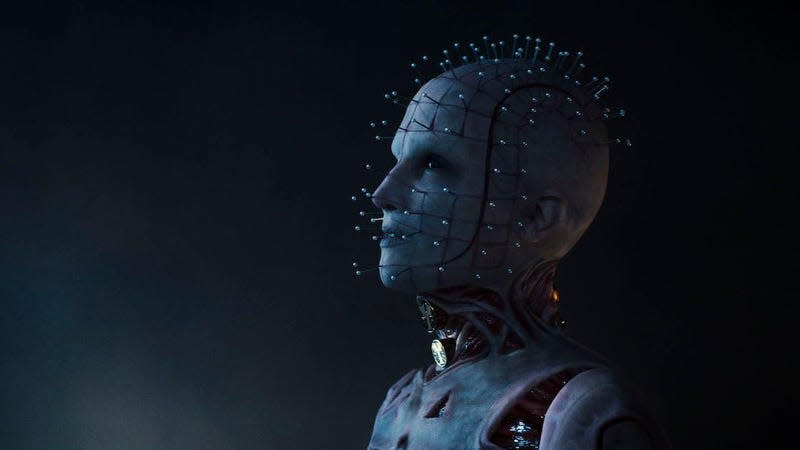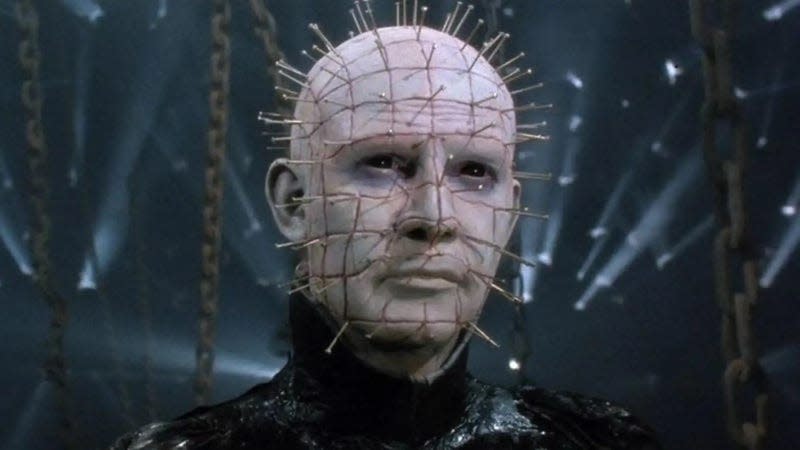What you need to know before watching the new Hellraiser movie

- Oops!Something went wrong.Please try again later.
- Oops!Something went wrong.Please try again later.
- Oops!Something went wrong.Please try again later.
Get ready to dim the lights and put the kids to bed early, because the new Hellraiser is finally out of development, er, hell. In some ways, it feels like its signature blend of sexually charged body horror never really went away. Since the original film premiered in 1987, the franchise has been steadily humming along, profitability be damned, adding new films and lore without ever having a hugely successful outing.
For those who aren’t keeping track (which, unless you’re a die-hard fan, is most of us), the new film brings the total number of sequels to an even 10. And then there are the comics, books, games, Halloween costumes, theme-park mazes, and fan films. And there’s even an HBO show in the works. Pinhead is one of the most recognizable horror villains of all time, right up there alongside the likes of Jason, Freddy, and Michael. But how much do you know about the mythology of the franchise? If you don’t have time to watch all 10 previous films before Hellraiser begins streaming on Hulu on Oct. 7—and we don’t recommend it—this handy primer should catch you up on all you need to know.
Read more
A definitive but possibly questionable ranking of festival films, according to standing ovations
What to watch on Apple TV Plus: 14 best shows streaming right now
Hellraiser | Official Trailer | Hulu
A brief(-ish) history of Hellraiser on film
In 1986, Clive Barker wrote a novella called The Hellbound Heart. Just one year later he would make his directorial debut on the film adaptation, titled Hellraiser. It wasn’t an instant hit, especially with critics, but the film found a devoted cult audience among horror fans, with some overlap from the fetish community. That was enough to merit a sequel, Hellbound: Hellraiser II, which came out the following year and picked up right where its predecessor left off.
Hellraiser III: Hell On Earth followed a few years later, in 1992, and had a character address Pinhead by name onscreen for the first time. The franchise’s theatrical era came to an end in 1996 with Hellraiser: Bloodline. It was a famously troubled production (receiving an Alan Smithee credit for the director, who wished to remain anonymous), but it was also notable for a few key reasons. For one, it traces the history of the infamous puzzle box at the center of the narrative through three time periods—the 18th century, present-day 1996, and the far future. For another, it features Adam Scott in a supporting role and some really unfortunate hairstyles. This was the last Hellraiser film released in theaters.
Like every long-running franchise, Hellraiser has had its period of diminishing returns. In the 2000s, there were four direct-to-DVD sequels produced, none of which added much to the lore. The seventh and eighth films, Hellraiser: Deader and Hellraiser: Hellworld, were actually produced back-to-back as a condition of filming in Romania. Doug Bradley, who had played Pinhead since the beginning, did not come back after the eighth film and was subsequently replaced with pale imitators. The ninth film, Hellraiser: Revelations, was made on a shoestring budget and screened only once in 2011, for the production crew who worked on it. It was reported at the time that Dimension Films only produced it to avoid losing the rights to the franchise. There was another attempt to revive it with a 10th film, Hellraiser: Revelations, but that one got lost in the executive shuffle following the departure of convicted sex offender Harvey Weinstein from Dimension’s parent company Miramax. Revelations was eventually released by Lionsgate on home media and on-demand in 2018.
Which brings us up to date and to the latest film, simply titled Hellraiser. Despite the title, it’s not a remake or a retelling of the story in The Hellbound Heart, though it does play with some of the same themes. They’ve also changed things up this time by reimagining Pinhead as a woman (played by Jaime Clayton) and focusing on a female protagonist (Odessa A’zion).

So who is this Pinhead guy anyway?
The character, whose official name is the Hell Priest, is the leader of a faction of demonic creatures called Cenobites. It was the original makeup team who first coined the nickname Pinhead behind the scenes of the first film, and it stuck (much to Clive Barker’s chagrin).
We learned in Hellraiser II that Pinhead was originally a British soldier fighting in World War I before he was transformed into the iconic Cenobite persona now inseparable from the franchise. In Hellraiser III, he was separated into his two sides, the human Elliott Spencer and the demon Hell Priest, for a while before being reunited and banished to hell once again. There are times when his humanity comes through, but mostly he just wants to bring people into his little corner of hell and torture them for eternity. In the comics and Barker’s other writings, it’s revealed that the title of Hell Priest is handed down, and there may have been others prior to Spencer taking over in the early 20th century.
For the new film, director David Bruckner knew that his version couldn’t compete with the original, so he didn’t even try. In the production notes for the film, Bruckner says, “Doug Bradley’s portrayal of The Hell Priest may be the most iconic performance in horror. To try and replicate his work would be a mistake.”
We don’t yet know the human origins of this version, but she is intended to give off a sense of dangerous sexuality, which fits with the thematic connection between pain, pleasure, and punishment that run through the series.
Who (or what) are the Cenobites?

Cenobites are basically sadomasochistic demons from hell. Like Pinhead, their leader, they were once human before becoming so twisted by their sadomasochist urges they can’t distinguish between pain and pleasure. And they don’t know any safe words. They all have different looks, based on individual and varied forms of body mutilation.
The Cenobites reside in their own labyrinthine neighborhood of hell and worship an entity known as Leviathan. They can only appear in our dimension when someone is unfortunate or foolish enough to solve an intricate puzzle box, known as the Lament Configuration. Sometimes they stick around to cause trouble, other times they will take humans back with them to their realm and subject them to terrible experiments to test their limits. And since they exist beyond the mortal realm, this could potentially go on for eternity.
Here are some of the Cenobites we’ll see in the new film:
The Chatterer is a tall, lanky creature with exposed and bloody muscle and sinew, plus a pulled-back, lipless mouth, and no eyes. His chattering jaw is powered by a small motor on the back of his head.
The Weeper has dagger blades driven through her feet to create the disturbing effect of spiked heels.
The Gasp was inspired by an unnamed character in the original that fans referred to as “Deep Throat” because of the gaping hole in her throat.
The Asphyx is called that because the skin stretched over its face keeps it from breathing. It is slightly bent, with bound arms and pearl piercings surrounding its head.
The Mother sports a permanent baby bump, which goes great with her razor-tipped fingers and the fine veil of skin peeled from her scalp that falls over her eyes.
The Masque has ancient inscriptions tattooed down his chest and more writing on its back, including the names of all the people in the prosthetics FX workshop. His completely inexpressive face is just suspended from a wire frame, with the back of his head removed by VFX.
One puzzle you do not want to solve

If the first image most people commonly associate with the Hellraiser series is Pinhead, coming in at a close second would have to be “the box.” Officially called the Lament Configuration, or sometimes the Lemarchand Configuration, the familiar puzzle box is an essential element of any Hellraiser story. It’s the key that opens the doorway to the Cenobite dimension and summons them to our world.
As we found out in Hellraiser: Bloodline, the box was originally built by an 18th-century toymaker based on designs given to him by a depraved French aristocrat. It’s been summoning demons ever since. The only way to banish them once they’ve been summoned is to reverse the box back to its original arrangement. Of course, at some point later, the box eventually falls into new hands and the cycle repeats itself.
In the past, we’ve only seen the box in two configurations. In the new Hellraiser, there are six different stages, each with a different symbolic meaning. Fans will have to wait to see the film, however, to find out what those configurations look like and what they represent.
That should be enough background information to get you into the world of Hellraiser before the new film premieres on October 7. As for fully preparing you for the horrors that await, we make no promises there.

